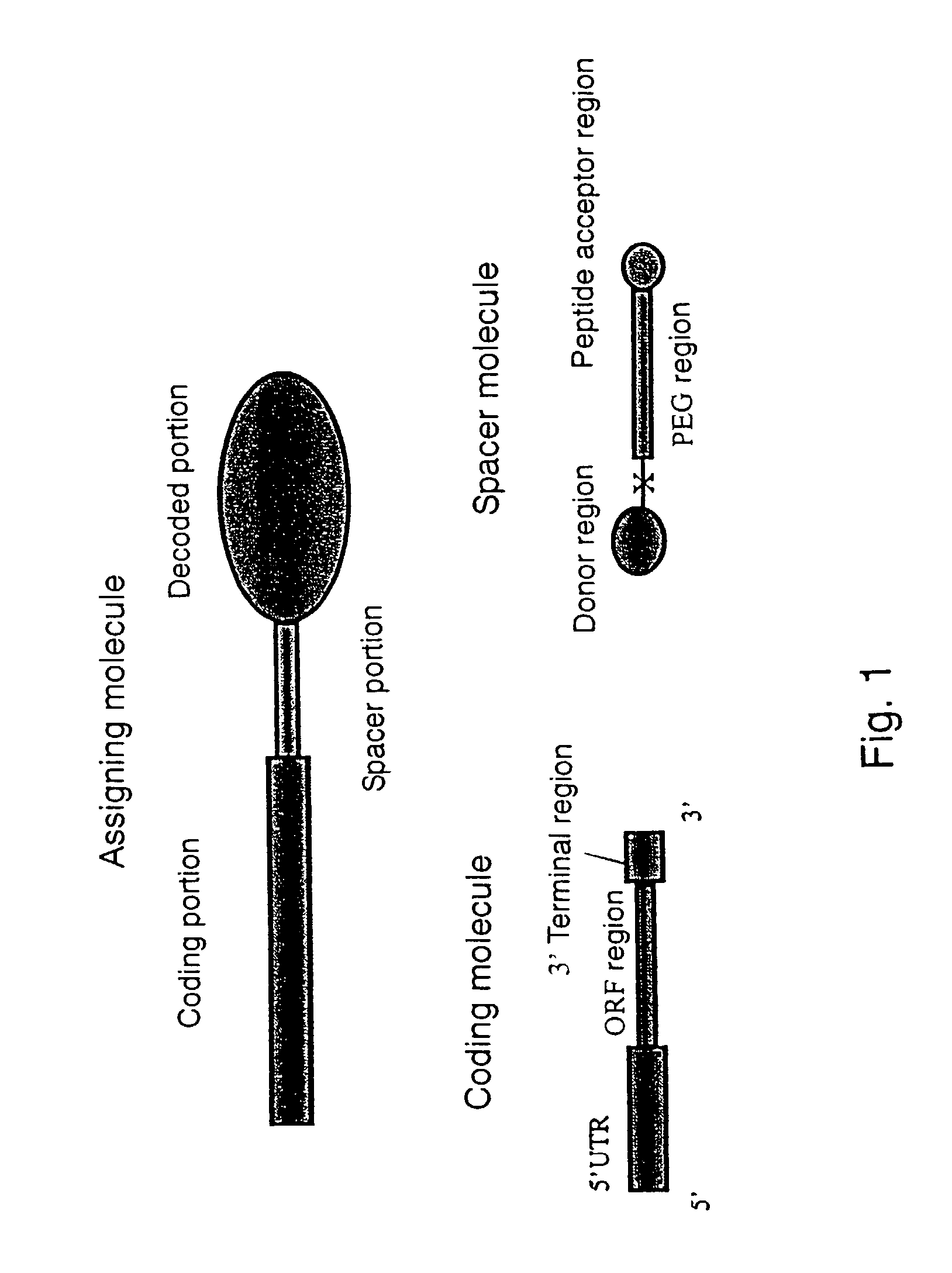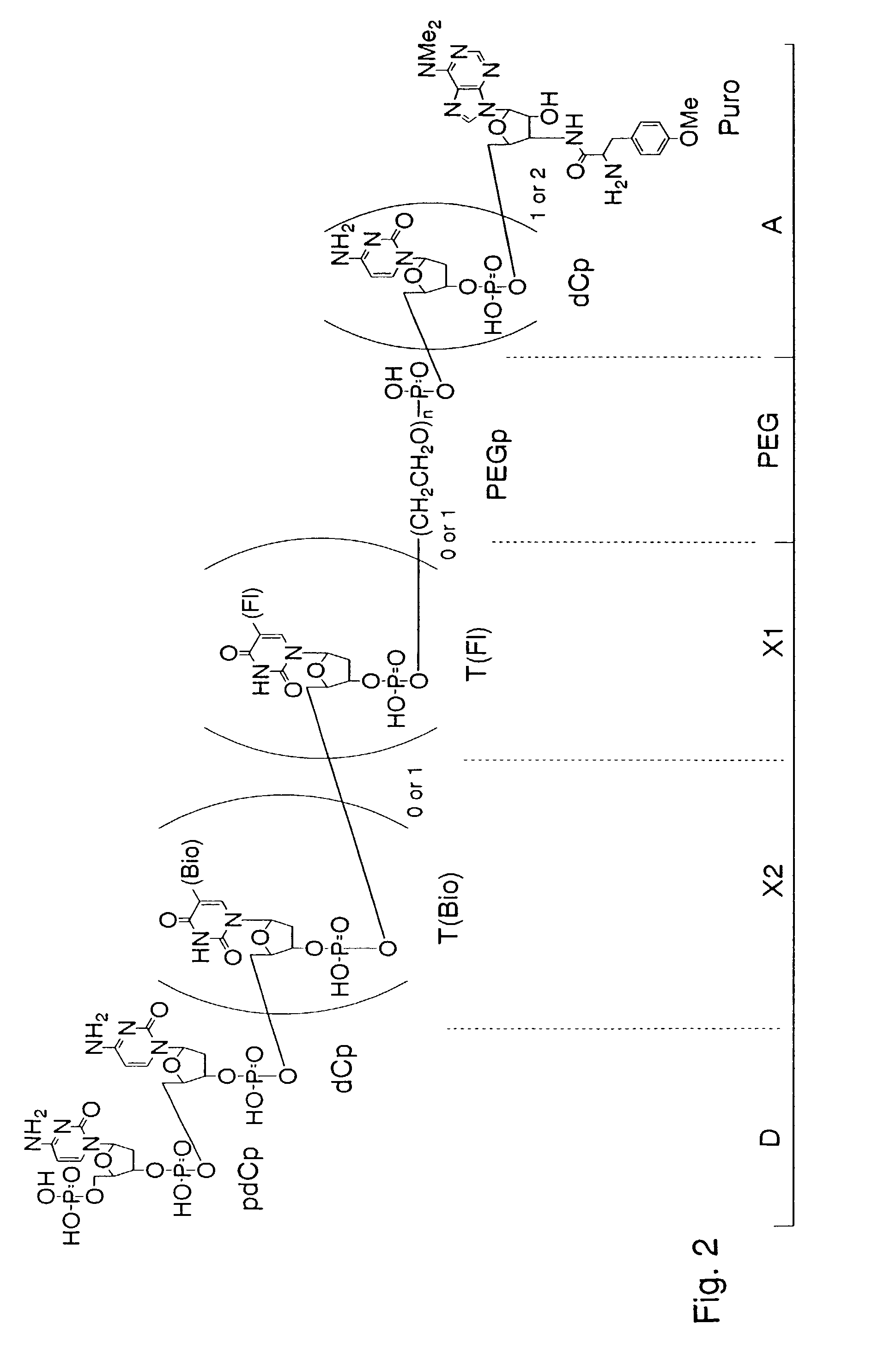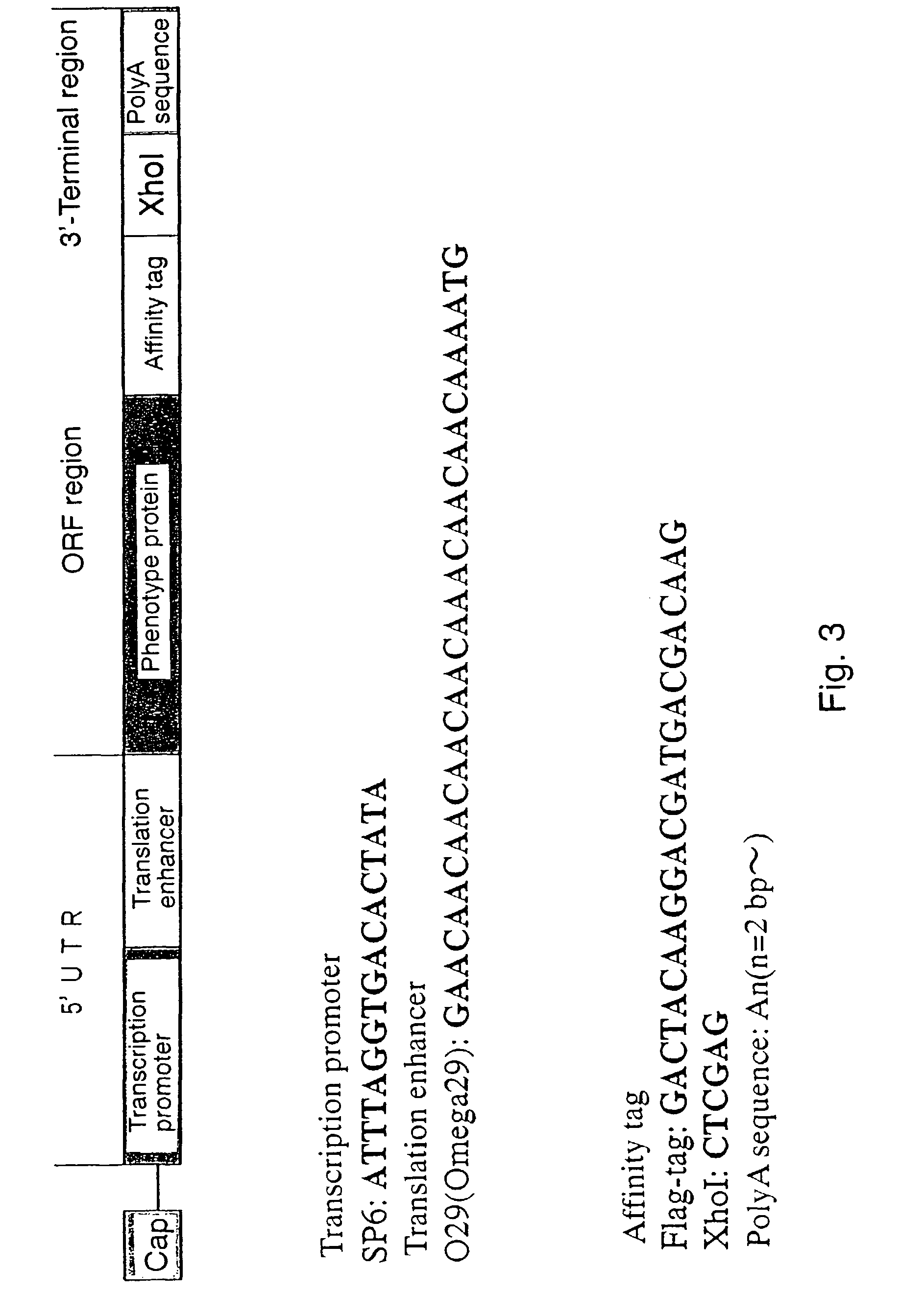[0084]The spacer molecule of the present invention serves as a spacer portion in an assigning molecule and is an improved spacer containing polyethylene glycol as a main component compared with a conventional spacer containing DNA as a main component. This makes possible to construct the assigning molecule not only in a rabbit reticulocyte translation system but also in a wheat germ cell-free translation system, markedly improve stability of the genotype molecule in both of the translation systems, and makes any post-translation treatment unnecessary.
[0085]It is epoch-making that the construction of the assigning molecule conventionally limited to the rabbit reticulocyte cell-free translation system (Nemoto, N., Miyamoto-Sato, E., Yanagawa, H. (1997) FEBS Lett., 414, 405; Roberts, R. W., Szostak, J. W. (1997) Proc. Natl. Acad. Sci. USA, 94, 12297) can be realized in a wheat germ cell-free translation system by using a spacer comprising an PEG region (PEG) containing polyethylene glycol as a main component instead of a conventional spacer containing DNA as a main component (Liu, R., Barrick, E., Szostak, J. W., Roberts, R. W. (2000) Methods in Enzymology, 318, 268-293; Nemoto, N., Miyamoto-Sato, E., Yanagawa, H. (1997) FEBS Lett., 414, 405; Roberts, R. W, Szostak, J. W. (1997) Proc. Natl. Acad. Sci. USA, 94, 12297). Further, in comparison with those using a conventional DNA spacer (S30 spacer: Liu R., Barrick E., Szoztak J. W., Roberts, R. W. (2000) Methods in Enzymology, 318, 268-293) or a spacer of containing DNA as a main component having a polyethylene glycol molecular weight of 400 or less (F30 spacer: Liu R., Barrick E., Szoztak J. W., Roberts, R. W. (2000) Methods in Enzymology, 318, 268-293), the genotype molecule containing the spacer portion of the present invention has significantly high stability in both of the rabbit and wheat translation systems and hence does not require post-treatment after assigning translation for improving assigning efficiency. Since the treatment after the assigning translation can be simplified, the working time for the assigning translation can be shortened from 48 to 72 hours to 0.5 to 1 hour. Further, since the stability of the genotype molecule is higher in the wheat germ cell-free translation system than in the rabbit reticulocyte cell-free translation system, the stability of genotype molecule can be made higher by the spacer portion containing the PEG region (PEG) as a main component in two ways. Therefore, it becomes possible to construct a library including coding portions having a long chain length and thereby increase diversity of the library.
[0086]By introducing a fluorescent substance into nucleotide of dT as a function-imparting unit (X), the assigning molecule, which is conventionally detected by using a radioisotope (RI) with much labor and time, can be readily detected based on fluorescence. Further, the assigning molecule can be separated and purified from a cell-free protein synthesis system by introducing biotin or any of various tags.
[0087]The reason why the stability of the genotype molecule containing a spacer portion derived from the spacer molecule of the present invention is high is considered that, since the 3′-terminal side is protected by a spacer portion having polyethylene glycol with no electric charge, mRNA having the spacer portion is prevented from being attacked by nuclease from the 3′-terminal side. Further, the reason why the post-translation treatment becomes unnecessary, and the assigning molecule can be constructed not only in a rabbit reticulocyte cell-free translation system, but also in a wheat germ cell-free translation system is considered that, since a spacer containing PEG as a main component causes no interaction with ribosome, other proteins or nucleic acids included in the translation system, degree of freedom for the spacer is increased not only in the rabbit reticulocyte cell-free translation system, but also in the wheat germ cell-free translation system in comparison with a DNA spacer, and puromycin of the spacer quickly enters into the A site on ribosome to accelerate a ligation reaction between puromycin and a protein.
[0088]The coding molecule of the present invention serves as the coding portion of the assigning molecule, and specific sequences can be used for the 5′-terminal and 3′-terminal sides of the coding molecule improve translation efficiency and further improve the assigning efficiency by 4 to 5 times.
[0089]Effect of improving the translation efficiency is exhibited with a constitution comprising 5′ UTR comprising a transcription promoter and a translation enhancer, comprising DNA and / or RNA; an ORF region comprising the main sequence of a decoded portion; and further a 3′-terminal region comprising the polyA sequence, comprising DNA and / or RNA. It is known that a polyA sequence stabilizes mRNA, and its average length is said to be several hundred bp in eukaryote. However, the polyA sequence having a length of 10 bp or less is particularly effective in the present invention. Further, the polyA sequence is generally a sequence contained in 3′ UTR and is not translated. However, in the present invention, the polyA sequence may be translated to constitute a part of the decoded portion. Further, it is generally known that translation efficiency is improved with a full-length omega sequence as for the enhancer sequence compared with a short omega sequence (Gallie, D. R., Walbot, V. (1992) Nucleic Acids Res., 20, 4631-4638). However, in the present invention, a short omega sequence (O29 in FIG. 3) shows better translation efficiency to the contrary. The reason for such novel effect is considered that particular effects such as better stability of a genotype molecule containing the O29 sequence compared with that of a genotype molecule containing a full-length omega sequence may possibly result from a combination of the 5′ UTR and the 3′-terminal region. In actual examinations, the genotype molecule was more stable when the 5′ UTR contained O29 containing a part of the omega sequence rather than the full-length omega sequence.
 Login to view more
Login to view more 


